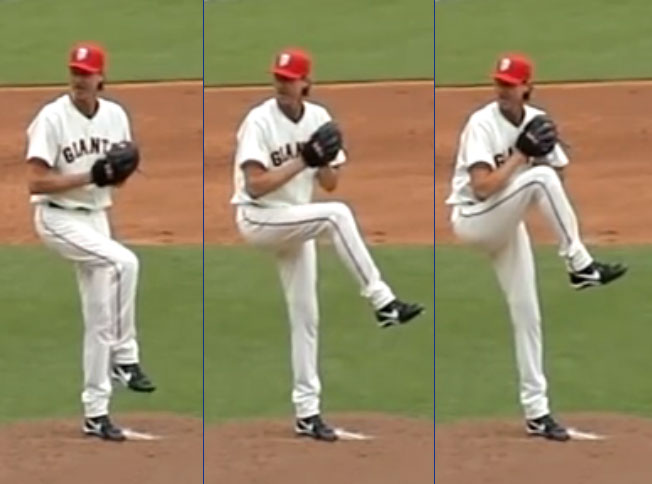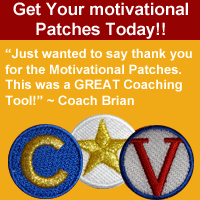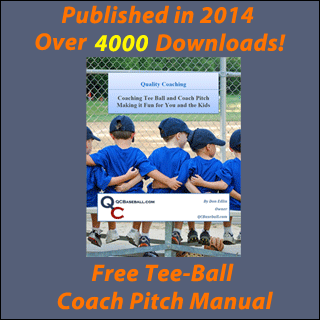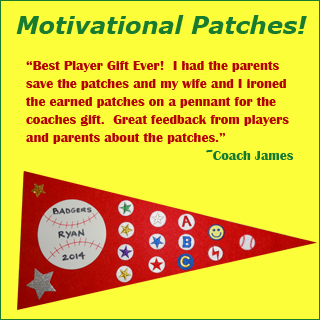Pitching - Windup
In higher levels of baseball the windup is used when there are no runners on base or when there are no runners with a potiential to steal a base (bases loaded for example). In Little League where runners cannot steal until the ball crosses the plate, the windup can be used all the time as the need to hold a runner on base is not an issue.
Why two different motions, the windup and the stretch? Why not just use the stretch all the time? There may be a few different reasons a player uses the windup when possibile. First, the windup tends to be a more relaxing position to start from. When a pitcher is in the stretch and a runner is on base, there is a tension there because focus is not only on the batter, but on the runner as well. There is also a focus on getting the ball to the plate quickly, by possibly reducing the leg kick or generally trying to be quicker. Simply put pitching in this manner is more stressful and can be a difficult mindset to get out of even with no runners on base. Second, most pitchers feel that the windup can give them a little extra momentum throughout the motion and they can accually throw the ball a little harder from the windup than the stretch.
Now that we've covered a couple of reasons why the windup is used, let's get into how to teach the windup to your players.
Stance
As with hitting, I believe one of the biggest problems with young pitchers is balance throughout the pitching motion. Watch any youth baseball games and you'll see kids get on the mound that struggle with their balance througout the windup and yet the coaches expect them to throw strikes.
Good balance starts with a good starting position. Some pitchers will stand with both feet lined up and some will stand with the stride leg slightly behind or to the side. There are a couple of things that I think are important here:
- Bend the knees slightly - There are not many athletic movement that begin with the knees locked and pitching isn't the execption.
- Don't have a wide stance - a wide stance makes it difficult to get balanced and stay balanced. I try to get my kids to minimize the amount of movement so balance is easier to attain and keep throughout the motion.
- Be slightly closed - if you think of the stretch or midway through the throwing motion, the body is going to be perpendicular to home plate, so by closing up slightly at the start it can make it easier for a player to get their foot placed properly on the mound and their body in the correct position.
The following is a good video on setting up to pitch from the windup:
The position of the glove and pitching hand also changes from pitcher to pitcher. I try to get my pitchers to start with their hand gripping the ball in their glove in the center of the chest. This should be a comfortable position and the glove should not too close to the body. I know I sound like a broken record (sad that kids don't even know what that is) but all the little things that help improve balance will add up to improve overall balance. Having the arms and hands away from the body will improve balance.
Coaching Advice
Try to get your pitchers comfortable pitching from different parts of the rubber. The main reason for this is the fact you don't have a grounds crew fixing the mound between innings or even before the game. Some mounds will be in such poor condition that fixing them at game time will be impossible. A pitcher will need to be able to pitch comfortably from different areas of the rubber to utilize the best possible landing zone for the stride foot on a poor mound.
Take A Step Back and to the Side (Not too big)
The video above did a good job of adressing the importance of a small step in keeping balanced. Young pitchers really need to work hard on this and as a coach it's one of the first things you should work with your kids on.
As the weight is transferred to the back leg, the front foot will be turned and placed parallel to, in contact with, and in front of the rubber. The feet are now in position to begin the kick.
Coaching Advice
It's important to realize that when we talk about balance for the pitcher's windup, it doesn't mean that the pitcher should be straight up and down and be able to hold that position at the top of the leg kick. Often that's what is thought of when we talk about a pitcher and balance. Rather think of balance in the pitching motion as side to side rather than up and down. We want our pitchers to be balanced from side to side as they go through their entire pitching motion and have a slight forward lean as they get to the top of the kick. See the image below. If not it will be impossible to develop a consistent pitching motion that results in good control.
Forward Lean

The Arms
At the same time the pitcher takes the step back, the arms will also move. Pitchers will either swing both arms over the top of their heads as they step back and begin pivoting their front foot (not very common), or (more likely) they will keep their hands in front of their chest and move directly into the top of the kick from that position.
Top Of The Kick
Once the front foot has pivoted and the hands have reached the top. The pitcher will shift his weight onto the pivoted foot and pull the back leg forward and up, swiveling as he does this until the his thigh is parallel to the ground or a little higher. His body should be sideways to the plate. Make sure your planted leg is not locked at the knee, it should be slightly flexed.
The critical element is balance. That doesn't mean that the pitcher should be able to hold this position. In fact, the pitcher should be moving forward as he reaches the top of the kick and should have some forward lean to his body (towards home plate) to help get moving in that direction. Many young pitchers are taught (and I used to teach as well) to get to the balance point where you can hold that position. While this is supposed to show good balance it really only helps if the goal is to stop there. Since our goal is to pitch the ball, a slight forward lean will actually help the young pitcher keep their entire motion in balance because they won't have the opportunity to go too far back at the top of their kick and get their balance going in the wrong direction.
The pitching motion is a combination of many movements that need to be executed exactly the same way with every pitch. Without balance at this point consistency in the pitching motion is impossible and without consistency in the motion, there is no chance of having good control.
Reaching Back
When an outfielder is fielding a fly ball and needs to make a throw, to the plate for example, the outfielder will try to get a few feet behind the spot where he will catch the ball and then will move in to it to gain momentum toward the target while catching the ball. Pitchers don't have this luxury on the mound. That doesn't mean there isn't a way to gain some momentum towards the plate.
A common mistake with young pitchers is to simply starting falling forward from the top of their kick toward the plate. Not only is this going to cause a common problem of the arm falling behind in the windup, it will also cause a loss of velocity. The arm will receive little benefit from the body when this happens.
From the top of the kick position the pitcher needs to do a few things that all must come together in order to gain momentum towards home. As the throwing arm drops the pitcher needs to reach down and back towards 2nd base. Again the throwing motion is circular and the pitcher wants the largest circle possible when pitching. Balance is still essential at this point. Reaching down and back with the throwing arm will naturally tilt the front hip up higher than the back hip. The pitcher is now in a position to stride forward toward the plate.
Push and Rotation
Both legs play an import role at this point in propelling the pitcher toward the plate. The front leg is lowered and driven forward towards the plate in a circular motion that swivels the hips open. At the same time the back leg is pushing off the rubber propelling the pitcher forward to the batter. The combination of these two motions performed correctly will not only add velocity to the fastball but also take pressure off the throwing arm.
It's important to note that most of the power will be generated from the rotation of the hips and a natural stride toward the plate. Many times young pitchers will try to gain velocity by dropping down further on their back leg and driving hard off that leg towards the plate. This will cause fatigue in the pitcher and can also result in the arm not being able to catch up with the body.
The Stride
The stride should be a comfortable distance, not too short that you're not getting the benefit of your lower body in your delivery and not too long that you land on your heel.
You should land on the ball of your foot with your leg slightly bent. Your foot should land in the same spot on every pitch and be positioned a few inches to the glove hand side of your back foot. This will ensure that you get the full benefit of the hip rotation.
The arm should follow through naturally across your body and the back leg should come forward and land close to parallel to your lead foot. This will put you in a good position to field your position.
Most Recent Blog Posts
Working With Players on Focusing on the Correct Part of the Baseball when Hitting (October 15 2016)
Getting More Accurate Throws From Your Team (April 5 2016)
Just wanted to say Thank you for the great website. Great information for this new coach. It sounds like baseball gave a lot to your life, so thanks for giving back to baseball.
- Ray K.







